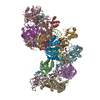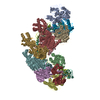+ Open data
Open data
- Basic information
Basic information
| Entry | Database: PDB / ID: 5u0a | ||||||
|---|---|---|---|---|---|---|---|
| Title | CRISPR RNA-guided surveillance complex | ||||||
 Components Components |
| ||||||
 Keywords Keywords | IMMUNE SYSTEM / CRISPR-Cas / Cascacde / surveillance | ||||||
| Function / homology |  Function and homology information Function and homology informationmaintenance of CRISPR repeat elements / defense response to virus / RNA binding / identical protein binding Similarity search - Function | ||||||
| Biological species |   Thermobifida fusca (bacteria) Thermobifida fusca (bacteria)  Thermobifida fusca YX (bacteria) Thermobifida fusca YX (bacteria) | ||||||
| Method | ELECTRON MICROSCOPY / single particle reconstruction / cryo EM / Resolution: 3.3 Å | ||||||
 Authors Authors | Xiao, Y. / Luo, M. / Hayes, R.P. / Kim, J. / Ng, S. / Ding, F. / Liao, M. / Ke, A. | ||||||
 Citation Citation |  Journal: Cell / Year: 2017 Journal: Cell / Year: 2017Title: Structure Basis for Directional R-loop Formation and Substrate Handover Mechanisms in Type I CRISPR-Cas System. Authors: Yibei Xiao / Min Luo / Robert P Hayes / Jonathan Kim / Sherwin Ng / Fang Ding / Maofu Liao / Ailong Ke /  Abstract: Type I CRISPR systems feature a sequential dsDNA target searching and degradation process, by crRNA-displaying Cascade and nuclease-helicase fusion enzyme Cas3, respectively. Here we present two cryo- ...Type I CRISPR systems feature a sequential dsDNA target searching and degradation process, by crRNA-displaying Cascade and nuclease-helicase fusion enzyme Cas3, respectively. Here we present two cryo-EM snapshots of the Thermobifida fusca type I-E Cascade: (1) unwinding 11 bp of dsDNA at the seed-sequence region to scout for sequence complementarity, and (2) further unwinding of the entire protospacer to form a full R-loop. These structures provide the much-needed temporal and spatial resolution to resolve key mechanistic steps leading to Cas3 recruitment. In the early steps, PAM recognition causes severe DNA bending, leading to spontaneous DNA unwinding to form a seed-bubble. The full R-loop formation triggers conformational changes in Cascade, licensing Cas3 to bind. The same process also generates a bulge in the non-target DNA strand, enabling its handover to Cas3 for cleavage. The combination of both negative and positive checkpoints ensures stringent yet efficient target degradation in type I CRISPR-Cas systems. | ||||||
| History |
|
- Structure visualization
Structure visualization
| Movie |
 Movie viewer Movie viewer |
|---|---|
| Structure viewer | Molecule:  Molmil Molmil Jmol/JSmol Jmol/JSmol |
- Downloads & links
Downloads & links
- Download
Download
| PDBx/mmCIF format |  5u0a.cif.gz 5u0a.cif.gz | 642.1 KB | Display |  PDBx/mmCIF format PDBx/mmCIF format |
|---|---|---|---|---|
| PDB format |  pdb5u0a.ent.gz pdb5u0a.ent.gz | 517.8 KB | Display |  PDB format PDB format |
| PDBx/mmJSON format |  5u0a.json.gz 5u0a.json.gz | Tree view |  PDBx/mmJSON format PDBx/mmJSON format | |
| Others |  Other downloads Other downloads |
-Validation report
| Summary document |  5u0a_validation.pdf.gz 5u0a_validation.pdf.gz | 1.1 MB | Display |  wwPDB validaton report wwPDB validaton report |
|---|---|---|---|---|
| Full document |  5u0a_full_validation.pdf.gz 5u0a_full_validation.pdf.gz | 1.2 MB | Display | |
| Data in XML |  5u0a_validation.xml.gz 5u0a_validation.xml.gz | 106.8 KB | Display | |
| Data in CIF |  5u0a_validation.cif.gz 5u0a_validation.cif.gz | 164.7 KB | Display | |
| Arichive directory |  https://data.pdbj.org/pub/pdb/validation_reports/u0/5u0a https://data.pdbj.org/pub/pdb/validation_reports/u0/5u0a ftp://data.pdbj.org/pub/pdb/validation_reports/u0/5u0a ftp://data.pdbj.org/pub/pdb/validation_reports/u0/5u0a | HTTPS FTP |
-Related structure data
| Related structure data |  8478MC  8477C  5u07C C: citing same article ( M: map data used to model this data |
|---|---|
| Similar structure data |
- Links
Links
- Assembly
Assembly
| Deposited unit | 
|
|---|---|
| 1 |
|
- Components
Components
-CRISPR-associated protein, ... , 4 types, 9 molecules ACDEFGHIN
| #1: Protein | Mass: 26327.938 Da / Num. of mol.: 1 Source method: isolated from a genetically manipulated source Source: (gene. exp.)   Thermobifida fusca (strain YX) (bacteria) Thermobifida fusca (strain YX) (bacteria)Strain: YX / Gene: Tfu_1588 / Production host:  | ||
|---|---|---|---|
| #2: Protein | Mass: 61433.297 Da / Num. of mol.: 1 Source method: isolated from a genetically manipulated source Source: (gene. exp.)   Thermobifida fusca (strain YX) (bacteria) Thermobifida fusca (strain YX) (bacteria)Strain: YX / Gene: Tfu_1592 / Production host:  | ||
| #3: Protein | Mass: 41043.043 Da / Num. of mol.: 6 Source method: isolated from a genetically manipulated source Source: (gene. exp.)   Thermobifida fusca (strain YX) (bacteria) Thermobifida fusca (strain YX) (bacteria)Strain: YX / Gene: Tfu_1590 / Production host:  #7: Protein | | Mass: 28279.260 Da / Num. of mol.: 1 Source method: isolated from a genetically manipulated source Source: (gene. exp.)   Thermobifida fusca (strain YX) (bacteria) Thermobifida fusca (strain YX) (bacteria)Strain: YX / Gene: Tfu_1589 / Production host:  |
-DNA chain , 2 types, 2 molecules MO
| #6: DNA chain | Mass: 15251.741 Da / Num. of mol.: 1 / Source method: obtained synthetically / Source: (synth.)   Thermobifida fusca YX (bacteria) Thermobifida fusca YX (bacteria) |
|---|---|
| #8: DNA chain | Mass: 12076.723 Da / Num. of mol.: 1 / Source method: obtained synthetically / Source: (synth.)   Thermobifida fusca YX (bacteria) Thermobifida fusca YX (bacteria) |
-Protein / RNA chain , 2 types, 3 molecules JLK
| #4: Protein | Mass: 27446.613 Da / Num. of mol.: 2 Source method: isolated from a genetically manipulated source Source: (gene. exp.)   Thermobifida fusca (strain YX) (bacteria) Thermobifida fusca (strain YX) (bacteria)Strain: YX / Gene: Tfu_1591 / Production host:  #5: RNA chain | | Mass: 19790.793 Da / Num. of mol.: 1 / Source method: obtained synthetically / Details: RNA was prepared by in vitro transcription / Source: (synth.)   Thermobifida fusca YX (bacteria) Thermobifida fusca YX (bacteria) |
|---|
-Experimental details
-Experiment
| Experiment | Method: ELECTRON MICROSCOPY |
|---|---|
| EM experiment | Aggregation state: PARTICLE / 3D reconstruction method: single particle reconstruction |
- Sample preparation
Sample preparation
| Component | Name: CRISPR RNA-guided surveillance complex / Type: COMPLEX / Entity ID: all / Source: RECOMBINANT |
|---|---|
| Source (natural) | Organism:   Thermobifida fusca (strain YX) (bacteria) Thermobifida fusca (strain YX) (bacteria) |
| Source (recombinant) | Organism:  |
| Buffer solution | pH: 7.5 / Details: 10 mM HEPES pH 7.5, 150 mM NaCl, 5 mM DTT |
| Specimen | Conc.: 0.8 mg/ml / Embedding applied: NO / Shadowing applied: NO / Staining applied: NO / Vitrification applied: YES |
| Specimen support | Grid material: COPPER / Grid type: 400 mesh Quantifoil holey carbon grid |
| Vitrification | Instrument: GATAN CRYOPLUNGE 3 / Cryogen name: ETHANE / Humidity: 85 % |
- Electron microscopy imaging
Electron microscopy imaging
| Experimental equipment |  Model: Tecnai Polara / Image courtesy: FEI Company |
|---|---|
| Microscopy | Model: FEI POLARA 300 |
| Electron gun | Electron source:  FIELD EMISSION GUN / Accelerating voltage: 300 kV / Illumination mode: FLOOD BEAM FIELD EMISSION GUN / Accelerating voltage: 300 kV / Illumination mode: FLOOD BEAM |
| Electron lens | Mode: BRIGHT FIELD / Nominal magnification: 31000 X / Calibrated defocus min: 1000 nm / Calibrated defocus max: 21000 nm / Cs: 2 mm |
| Specimen holder | Cryogen: NITROGEN / Specimen holder model: GATAN LIQUID NITROGEN / Temperature (max): 105 K / Temperature (min): 80 K |
| Image recording | Electron dose: 8 e/Å2 / Detector mode: COUNTING / Film or detector model: GATAN K2 SUMMIT (4k x 4k) / Num. of real images: 1072 |
- Processing
Processing
| Software | Name: PHENIX / Version: 1.11.1-2575_1692: / Classification: refinement | ||||||||||||||||||||||||||||||||||||||||||||
|---|---|---|---|---|---|---|---|---|---|---|---|---|---|---|---|---|---|---|---|---|---|---|---|---|---|---|---|---|---|---|---|---|---|---|---|---|---|---|---|---|---|---|---|---|---|
| EM software |
| ||||||||||||||||||||||||||||||||||||||||||||
| CTF correction | Type: PHASE FLIPPING AND AMPLITUDE CORRECTION | ||||||||||||||||||||||||||||||||||||||||||||
| Particle selection | Num. of particles selected: 303301 | ||||||||||||||||||||||||||||||||||||||||||||
| Symmetry | Point symmetry: C1 (asymmetric) | ||||||||||||||||||||||||||||||||||||||||||||
| 3D reconstruction | Resolution: 3.3 Å / Resolution method: FSC 0.143 CUT-OFF / Num. of particles: 131292 / Symmetry type: POINT | ||||||||||||||||||||||||||||||||||||||||||||
| Atomic model building | Protocol: OTHER | ||||||||||||||||||||||||||||||||||||||||||||
| Refine LS restraints |
|
 Movie
Movie Controller
Controller










 PDBj
PDBj































































